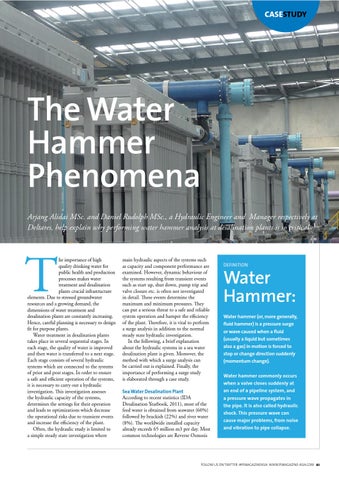CASESTUDY
The Water Hammer Phenomena Arjang Alidai MSc. and Daniel Rudolph MSc., a Hydraulic Engineer and Manager respectively at Deltares, help explain why performing water hammer analysis at desalination plants is so critical
T
he importance of high quality drinking water for public health and production processes makes water treatment and desalination plants crucial infrastructure elements. Due to stressed groundwater resources and a growing demand, the dimensions of water treatment and desalination plants are constantly increasing. Hence, careful planning is necessary to design fit for purpose plants. Water treatment in desalination plants takes place in several sequential stages. In each stage, the quality of water is improved and then water is transferred to a next stage. Each stage consists of several hydraulic systems which are connected to the systems of prior and post stages. In order to ensure a safe and efficient operation of the systems, it is necessary to carry out a hydraulic investigation. This investigation assesses the hydraulic capacity of the systems, determines the settings for their operation and leads to optimizations which decrease the operational risks due to transient events and increase the efficiency of the plant. Often, the hydraulic study is limited to a simple steady state investigation where
main hydraulic aspects of the systems such as capacity and component performance are examined. However, dynamic behaviour of the systems resulting from transient events such as start up, shut down, pump trip and valve closure etc. is often not investigated in detail. These events determine the maximum and minimum pressures. They can put a serious threat to a safe and reliable system operation and hamper the efficiency of the plant. Therefore, it is vital to perform a surge analysis in addition to the normal steady state hydraulic investigation. In the following, a brief explanation about the hydraulic systems in a sea water desalination plant is given. Moreover, the method with which a surge analysis can be carried out is explained. Finally, the importance of performing a surge study is elaborated through a case study. Sea Water Desalination Plant
According to recent statistics (IDA Desalination Yearbook, 2011), most of the feed water is obtained from seawater (60%) followed by brackish (22%) and river water (8%). The worldwide installed capacity already exceeds 65 million m3 per day. Most common technologies are Reverse Osmosis
DEFINITION
Water Hammer: Water hammer (or, more generally, fluid hammer) is a pressure surge or wave caused when a fluid (usually a liquid but sometimes also a gas) in motion is forced to stop or change direction suddenly (momentum change). Water hammer commonly occurs when a valve closes suddenly at an end of a pipeline system, and a pressure wave propagates in the pipe. It is also called hydraulic shock. This pressure wave can cause major problems, from noise and vibration to pipe collapse.
FOLLOW US ON TWITTER: @PIMAGAZINEASIA WWW.PIMAGAZINE-ASIA.COM 83
